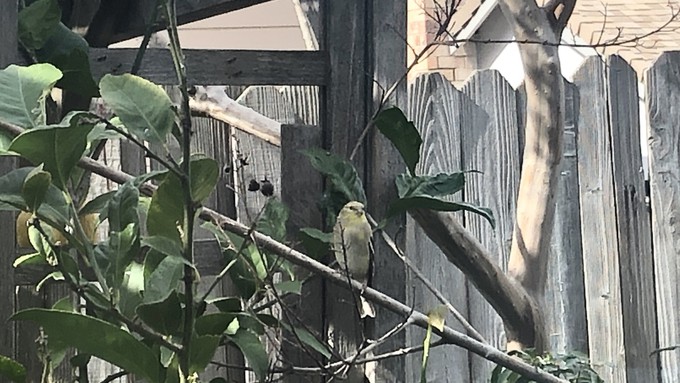
Great Backyard Bird Count can be done in parks or nature areas as well as at home

Whether it involves spotting lesser goldfinches in your backyard, as above, or myriad birds in a nearby wildlife site, anyone can participate this weekend in the Great Backyard Bird Count. Kathy Morrison
Got 15 minutes to spare for the birds? The Great Backyard Bird Count is back.
Starting Friday and through this holiday weekend, anyone can help contribute to a real-time snapshot of bird populations.
The National AudubonSociety naturally is involved in the event, and explains it like this:
“Participants are asked to count birds for as little as 15 minutes (or as long as they wish) on one or more days of the four-day event and report their sightings online at birdcount.org. Anyone can take part in the Great Backyard Bird Count, from beginning bird watchers to experts, and you can participate from your backyard, or anywhere in the world.”
How to participate? Here’s the guide from birdcount.org (also available at the link):
1) Count birds anywhere you like for at LEAST 15 minutes – or for as long as you wish. Keep track of the kinds of birds you see and how long you watched.
2) Make your best estimate of how many birds you saw of each species. For example, 5 Northern Cardinals, 3 American Crows. Huge flocks may be a challenge, but your best guess is still valuable.
3) Enter your list(s) online at www.birdcount.org. Put in a new checklist:
– for each new day
– for each different location
– for the same location, same day, if you counted at a different time of day.
The observation data are used by ornithologists to learn how birds are doing overall and how to protect them and the environment we all share.
Gardeners of course depend on birds to control insect pests as well as contribute to the diversity and beauty of our outdoor world.
If you’re not already familiar with the birds in your neighborhood, I recommend downloading the free Merlin app today, or at least before you start counting. (The account you create will be used to file your bird-count checklist, too.) Merlin was created by the Cornell Lab of Ornithology to help anyone identify, by photo or by sound, the birds around them. You can download a list of birds common to the western United States. I especially like to record on my phone the call or song of a bird I can’t see.
The Sacramento Audubon Society also maintains an online list of Sacramento-area birds, which is so helpful in learning all the feathered neighbors.
Birdcount.org also has excellent tips on identifying and counting birds.
You can be sure I'll be out in the wilds of my backyard Friday, with binoculars and phone at ready.
Comments
0 comments have been posted.Sacramento Digs Gardening to your inbox.
Food in My Back Yard Series
April 22: Should you stock up on fertilizer? (Yes!)
April 15: Grow culinary herbs in containers
April 8: When to plant summer vegetables
April 1: Don't be fooled by these garden myths
March 25: Fertilizer tips: How to 'feed' your vegetables for healthy growth
March 18: Time to give vegetable seedlings some more space
March 11: Ways to win the fight against weeds
March 4: Potatoes from the garden
Feb. 25: Plant a fruit tree now -- for later
Feb. 18: How to squeeze more food into less space
Feb. 11: When to plant? Consider staggering your transplants
Feb. 4: Starting in seed starting
Sites We Like
Garden Checklist for week of April 27
Once the clouds clear, get to work. Spring growth is in high gear.
* Set out tomato, pepper and eggplant transplants.
* From seed, plant beans, beets, cantaloupes, carrots, corn, cucumbers, melons, pumpkins, radishes and squash. Plant onion sets.
* In the flower garden, plant seeds for asters, cosmos, celosia, marigolds, salvia, sunflowers and zinnias. Transplant petunias, zinnias, geraniums and other summer bloomers.
* Plant perennials and dahlia tubers for summer bloom. Late April is about the last chance to plant summer bulbs, such as gladiolus and tuberous begonias.
* Transplant lettuce and cabbage seedlings.
* Weed, weed, weed! Don’t let unwanted plants go to seed.
* April is the last chance to plant citrus trees such as dwarf orange, lemon and kumquat. These trees also look good in landscaping and provide fresh fruit in winter.
* Feed citrus trees with a low dose of balanced fertilizer (such as 10-10-10) during bloom to help set fruit. Keep an eye out for ants.
* Apply slow-release fertilizer to the lawn.
* Thoroughly clean debris from the bottom of outdoor ponds or fountains.
* Start thinning fruit that's formed on apple and stone fruit trees -- you'll get larger fruit at harvest (and avoid limb breakage) if some is thinned now. The UC recommendation is to thin fruit when it is about 3/4 of an inch in diameter. Peaches and nectarines should be thinned to about 6 inches apart; smaller fruit such as plums and pluots can be about 4 inches apart. Apricots can be left at 3 inches apart. Apples and pears should be thinned to one fruit per cluster of flowers, 6 to 8 inches apart.
* Azaleas and camellias looking a little yellow? If leaves are turning yellow between the veins, give them a boost with chelated iron.
* Trim dead flowers but not leaves from spring-flowering bulbs such as daffodils and tulips. Those leaves gather energy to create next year's flowers. Also, give the bulbs a fertilizer boost after bloom.
* Pinch chrysanthemums back to 12 inches for fall flowers. Cut old stems to the ground.
* Mulch around plants to conserve moisture and control weeds.